5 Greenwashing Examples And How to Avoid Them in Your Brand’s Marketing
LAST UPDATED November 7, 2021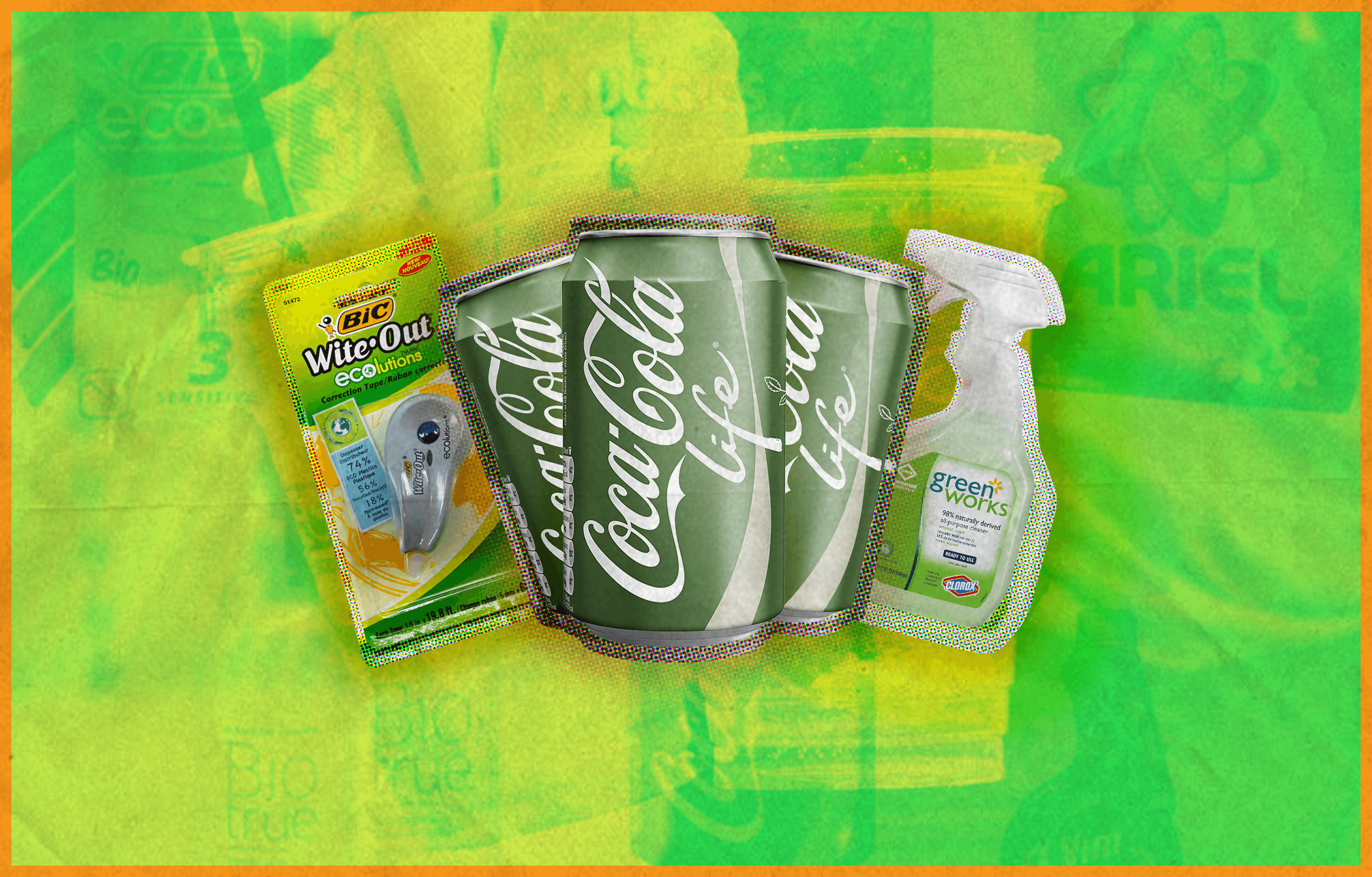
Greenwashing, Coloring the Fashion Industry in Deception
The green movement is booming, especially in the fashion industry. Consumers are realizing the disastrous impact fashion brands (most especially fast fashion brands) are having on the climate, workers, animals and the world’s oceans.
The environmentally conscious consumer of today searches for “green” products. It’s a sentiment growing within the clothing industry, as the younger consumer becomes more socially aware, making buying decisions based on the brand’s environmental impact. At the same time, for the younger consumer, most especially college students, it can be difficult to choose an environmentally friendly piece of clothing on a budget.
The constant conflict between quality, trends, and environmental factors has led to a shift in the fashion industry known as “greenwashing. ” Greenwashing refers to companies claiming that its products are environmentally friendly, when in reality, they are not. Essentially this tactic plays with consumers’ minds and emotions in order to take their money.
Let’s take a closer look at a few greenwashing examples, why greenwashing in fashion is such a common practice, and how you can avoid greenwashing in your brand’s marketing.
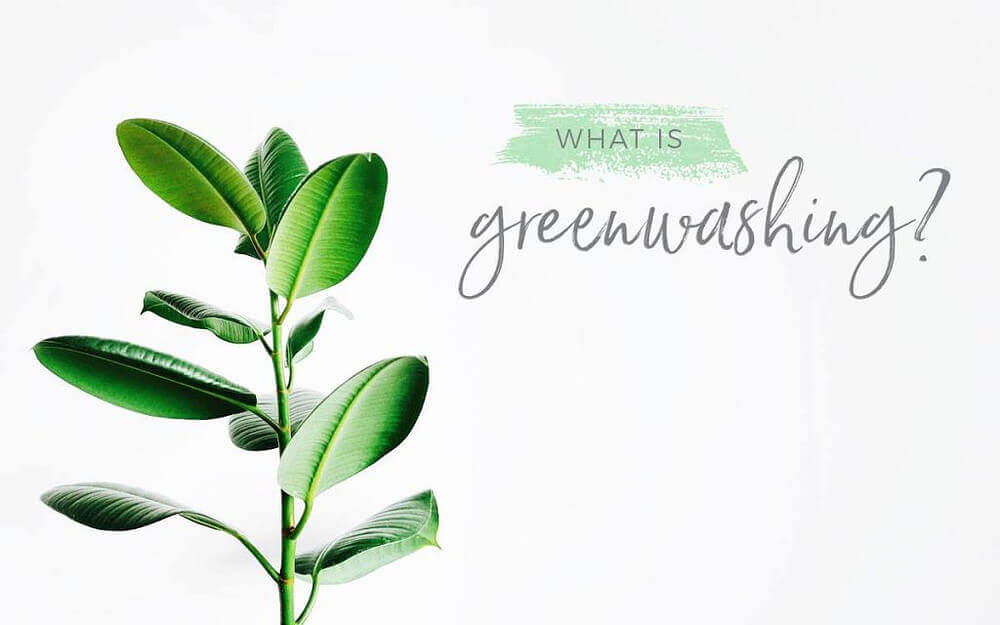
What is greenwashing?
The term ‘greenwashing’ was coined by environmentalist Jay Westervelt in 1986. Greenwashing refers to misleading advertisements or false claims by companies that suggest they are doing more for the environment than they actually are. Trying to appear greener, by making misleading claims about the environmental impact of business activity, is considered greenwashing. Many fashion brands are claiming to reduce its carbon footprint and environmental impact, while a large proportion of their activities remain detrimental to the planet.
Fashion brands that participate and profit from greenwashing do so by appealing to the eco-consciousness of today’s socially aware consumer.
So what are examples of greenwashing?
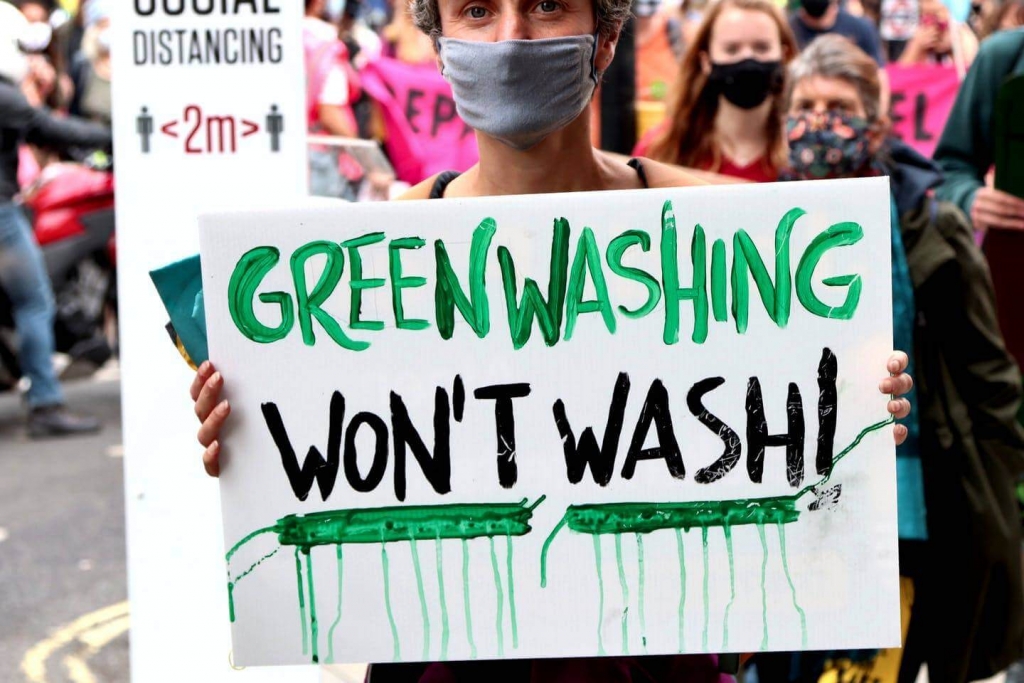
1) Making False Claims
Some examples of false claim-making are declaring that a product is made from 100% recycled materials or non-toxic dyes when they aren’t, stating that all products are cruelty-free or not tested on animals when they are or outright lying about an item containing 100% organic, fair-trade-sourced materials, but they don’t. This also happens when a brand claims it holds a special certification such as fair trade or organic, but they actually do not.
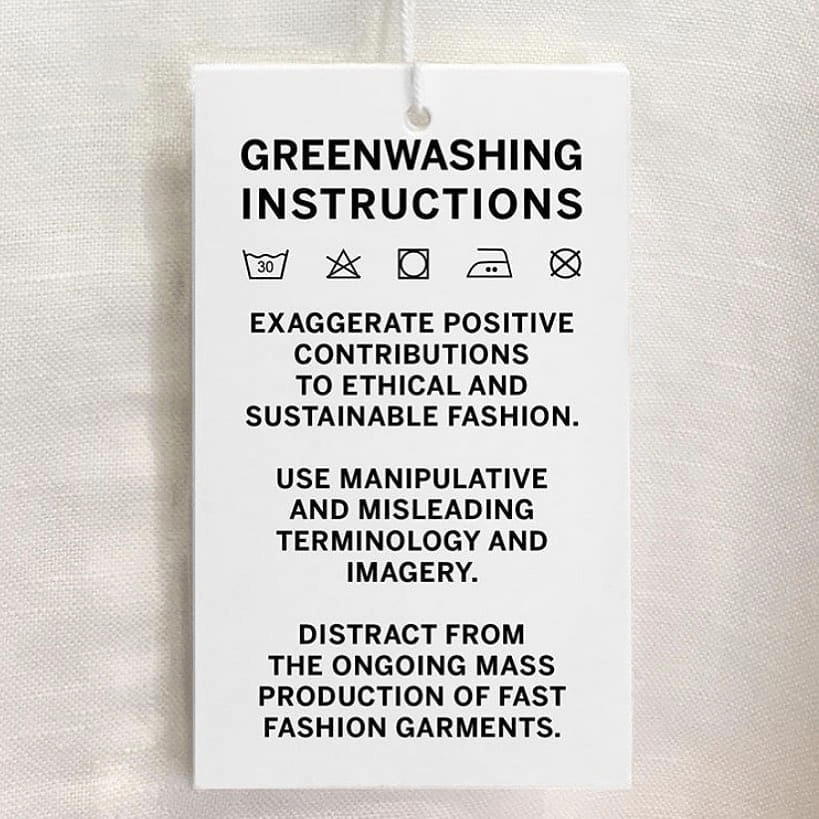
Making any environmental-related claim without actually providing sufficient evidence is categorized as greenwashing.
A false claim doesn’t have to be 100% false to be greenwashing. When brands launch a “conscious collection” or an “eco-friendly line,” for example, what percentage of the overall business do these lines represent? More often than not, these collections represent a small portion of a fashion company’s total range of product offerings.
2) Having Misleading Labels
Using misleading labels or phrases with no inherent significance (such as 100% green or all-natural) or the practice of using terms that are broad and cannot really be defined or understood is another example of greenwashing.
This practice is rampant in the fashion industry.
Brands often claim to use sustainable fabrics and throw out the words “vegan” and “natural” in its marketing. However, these terms don’t always equate to sustainability. Many vegan alternatives are made from synthetic plastic-derived materials that pollute the environment. Some brands will claim to use eco-vegan leather instead of toxic PVC made from petroleum. Yes, it’s vegan — but it’s certainly not sustainable.
3) Using Misleading Environmental Imageries

Many fast fashion brands utilize images of earth and nature in its marketing materials to promote environmental efforts and a commitment to sustainable practices. Photographs of lush rainforests, beautiful fields, and majestic mountains are an attempt to associate clothing with positive, desirable, and feel-good ideas of protecting nature. This weak tactic is not only blatantly obvious but also extremely condescending to the younger customer’s assumed lack of knowledge.
Likewise, earthy tones and colors, especially green, have been used and abused all too frequently. Traditionally, green packaging or labeling previously signified a product’s eco-friendly credibility. Presently, it’s almost a dead giveaway that the opposite may ring true.
4) Presenting Hidden Trade-Offs
The sin of hidden trade-offs is when a brand asserts that a product or collection is eco-friendly based on a small set of attributes without taking the full impacts of production into consideration.
An example of this is a fast fashion brand claiming to use partially recycled fabrics for their collections, and calling them “eco-friendly,” when in reality these garments are produced in excessive quantities of fossil-fuel-powered factories and are designed to go out of season in just a few months.
5) Lesser of Two Evils
The “lesser of two evils” is when a brand represents some eco-friendly products, but the whole product category is actually unsustainable.
The best example of this is a fast fashion brand insisting its collection is eco-friendly. (These fast-fashion companies fail to acknowledge the unsustainability of its very own business model.)
Yes, using more eco-friendly materials and dyes is certainly a step in the right direction. However, pushing for endless quantities, cheaper materials, and faster production is not, and never will be, sustainable.

This approach requires far too many resources, creates excessive waste, encourages overconsumption, and inevitably leads to labor exploitation.
Sustainable fashion must include more discussions about less. Any brand actually committed to sustainable fashion must have a focus on higher quality, longer-lasting materials, and fewer garments. Making clothes from green fabrics doesn’t help the environment if those garments fall apart after two wears or go out of style after one season. Additionally, no matter how ecologically responsible the materials used to create garments may be, it cannot be considered a sustainable brand if safe working conditions and fair living wages are not ensured.
So which brands are washing themselves in green?

1) H&M
H&M, one of the top fashion retailers in the world, is synonymous with fast fashion as it sells about 3 billion articles of clothing every year. This clothing company contributes to a cycle of cheaply made clothing — often at the risk and expense of the people who make them.
In an attempt to promote sustainability, H&M has launched multiple campaigns around circular fashion and recycled materials, using misleading labels to trick the consumer.
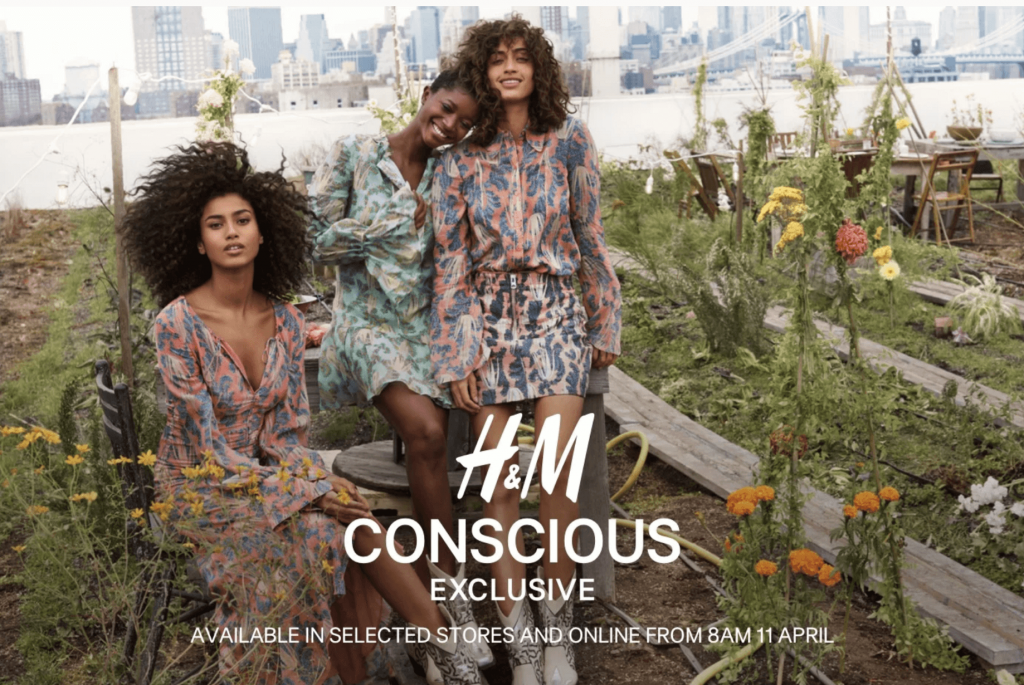
Campaigns like the Conscious Collection offered vague promises about being made of more sustainable materials without giving more information on how the items were produced and how the materials were better for the environment. Instead of hard numbers, H&M simply touted its use of new plant-based sustainable materials in the premium collection to create “high-performing, beautiful and fashionable” statement pieces.
Based on a study conducted by the World Wildlife Fund, H&M announced that one of their men’s “green” long sleeve shirts is made of 100% organic cotton but conveniently left out the fact that, on average, “it takes about 20,000 liters of water to produce that shirt.” Additionally, no details on the organic cotton certification or source are included in the brand’s website.
Beyond this, H&M has recently collaborated with Billie Eilish to produce a “sustainably-produced” line, without providing clear details on its claim.
The collaboration’s 16-piece collection consists of just 2 “conscious” pieces: a pair of joggers and a t-shirt. For a brand to boast its sustainability, and then be this brief and nonspecific, is unusual. One would think putting a buzzword such as “sustainable” in the spotlight would mean no loose ends to get tied up in.
Even if H&M is given the benefit of the doubt, assuming the 2 Conscious pieces are sustainably made, that’s only 2 pieces out of 16 in the entire collection. Does 12% of an entire collection give them the right to call it a “sustainable merch drop?” Industry standard says that for a brand to be considered “sustainable,” at least 50% (a simple majority) of their collections must be sustainably made. H&M falls short.
Many brands that don’t meet that threshold still try to stay true when it comes to the fabrics. H&M states that 87.5% of the Billie Eilish collection is made from cotton, polyester, and acrylic.
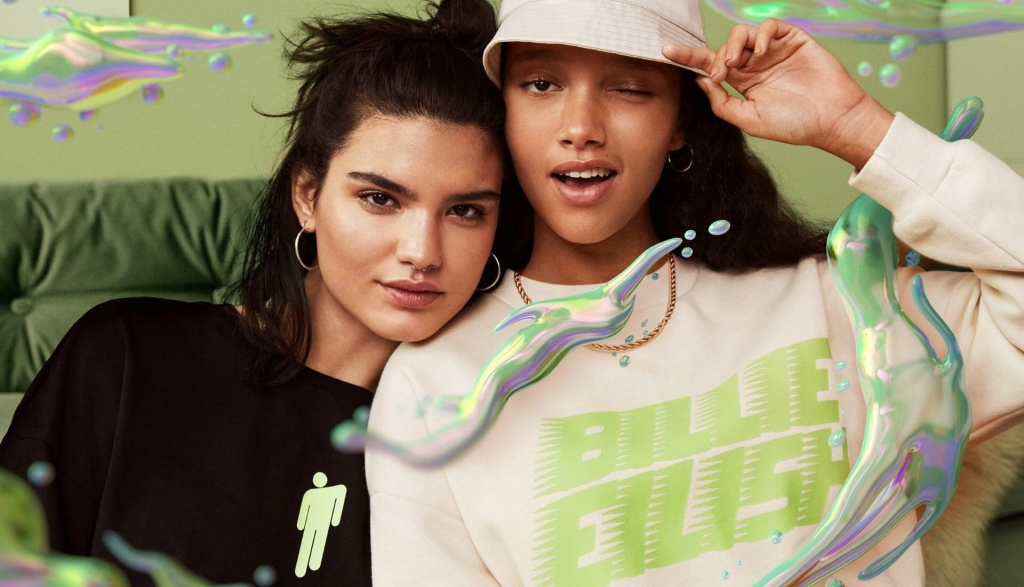
A recent study out of the UK revealed that polyester and acrylic are both derived from oil, not recycled or repurposed oil, making them among the least sustainable materials to use in clothing. As for cotton, it’s a thirsty crop that uses more chemical pesticides than any other crop.
In this case, it can be assumed that the company wanted to appeal to a younger audience by pairing a pop music fashion icon with vague and misleading terms. This is blatant greenwashing.
Hopefully, soon, brands like H&M will realize that younger people do research too, and aren’t as easily fooled as the fast fashion industry believes.
2) Zara
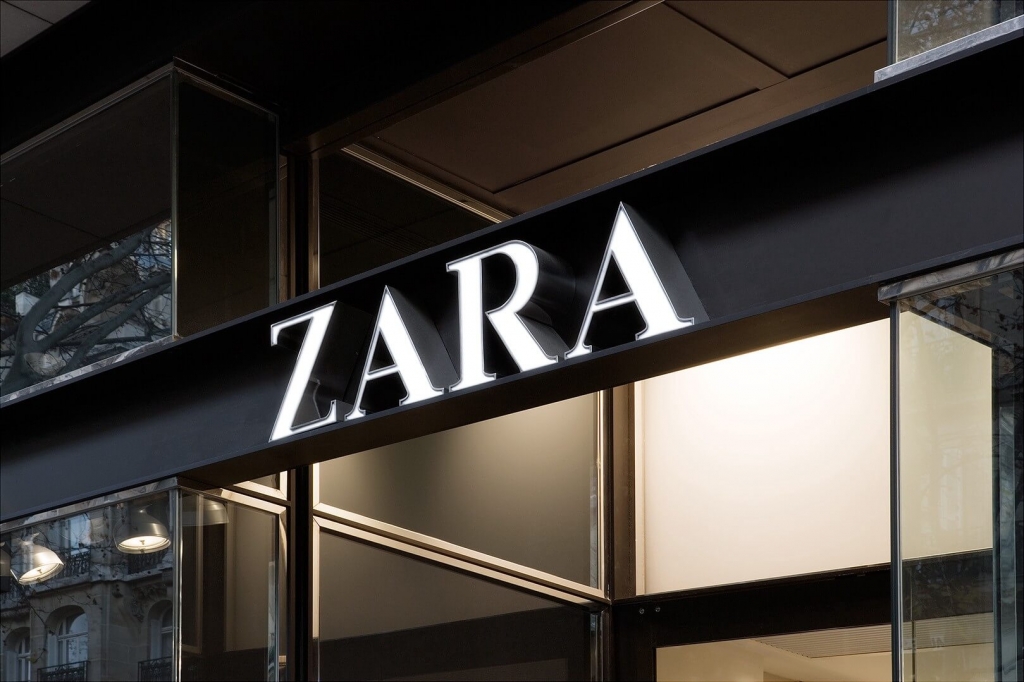
With thousands of retail outlets across the globe, Zara, owned by Spanish clothing conglomerate Inditex, has established itself as a heavyweight in the fast fashion industry. In 2012, Zara made a pledge to ensure that all hazardous chemicals would be removed from its operations by 2020. In 2016 the brand released an “eco-friendly” collection called “Join Life,” featuring what claims to be eco-friendly fabrics. Most recently, in 2019, Zara’s parent company announced a mission to use only sustainable materials by 2025.
However, as reported in The New York Times, when the brand produces more than 800 million garments a year, how much of an impact will that really have? The report suggests that regardless of how “sustainable” a material is, it is inevitable that a significant portion of these garments will end up as unnecessary waste. And when prominent fast fashion brands like Zara show so much profit from this significant output, other brands may feel pressured to follow suit and increase their own production.
3) The Body Shop
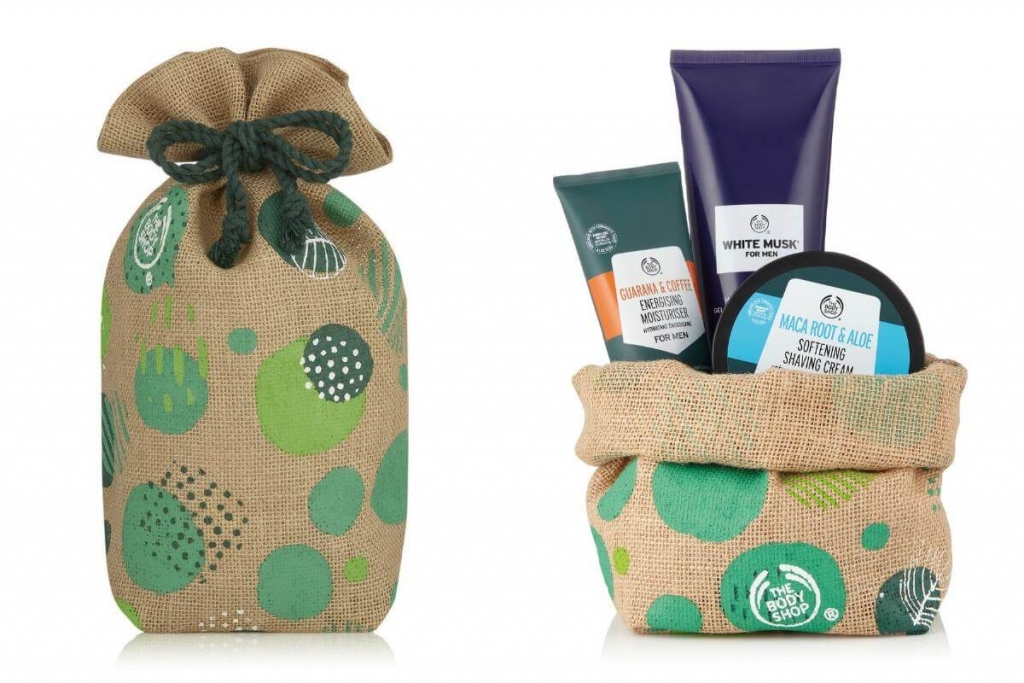
Founded in 1976 by Anita Roddick, The Body Shop was one of the first companies to decry animal testing and use Fair Trade, natural ingredients in their products. The Body Shop also champions various social causes and supports developing communities by purchasing hemp, Shea butter, and other locally harvested products. Unfortunately, the good news ends there.
While the company boasts its opposition to animal testing, the Body Shop’s goods come in plastic tubs or containers, and most scarily of all, they irradiate certain products to kill microbes; this radiation is generated from dangerous non-renewable uranium, which cannot be disposed of safely.
Therefore, while the brand may be boasting about the local communities producing hemp, its products are using plastics made from materials that are quite literally bombing the atmosphere of the planet.
4) Lululemon

A high-end activewear chain that offers yoga-inspired athletic apparel for most sweaty pursuits, the brand claims to be dedicated to sustainable practice. But, does Lululemon really put its best foot forward for people, the planet, and animals? While Lululemon is a member of the Sustainable Apparel Coalition and claims sustainability as one of its core principles, saying the brand is making a positive impact on the environment is definitely a stretch. Lululemon uses a low proportion of eco-friendly materials. While it has set a target goal to reduce greenhouse gas emissions generated from its owned operations and supply chain by 60% by 2030, there is no evidence it is on track to meet its target. There is no evidence it has taken meaningful action to reduce or eliminate hazardous chemicals, nor does it have adequate policies or initiatives on water reduction.
While several fashion brands are committed to true eco-positive initiatives, sadly, there are many brands bringing greenwashing in fashion to the collective-consciousness. The advertising consultant company, TerraChoice Environmental Marketing, concluded in a study on greenwashing from 2006 to 2009 that within 2,219 products making green claims, 98% of them were guilty of greenwashing. Greenwashing products presented on social media and promoted in advertising is another way many companies attempt to differentiate themselves from the competition. Promising a more efficient use of resources or energy catches the customers’ attention. Simply put, greenwashing is a marketing strategy used to increase sales and position brands in a better light through deception.
Greenbacking Greenwashing
Just because brands skimp out on actually making environmental improvements to greenwashed products doesn’t mean that these companies aren’t investing big bucks to try to make it seem as though they are. Instead of actually using resources for eco-friendly production methods or investing in more sustainable materials, companies are channeling funds into marketing campaigns that are extremely creative, effective, and costly. These companies pass that cost onto the consumer, justifying an increase in price by claiming a product is somehow environmentally friendlier.
These expensive marketing campaigns make it more challenging to distinguish a greenwashed product and a brand that’s truly green.
These fashion brands know that consumers often make buying decisions based on their emotions. This assumption is utilized when greenwashing taps into the good conscience of consumers.
7 Ways NOT to be a Greenwasher
So how do you as a marketer or an owner of a sustainable brand ensure that you don’t make the mistakes of larger brands like H&M, The Body Shop and Zara with intentional greenwashing? Here are seven ways to truly show your eco-friendly or ethical virtues without misleading future customers and supporters of the brand.
1) Be Intentional in Wording
Luring in consumers with nonspecific labeling like “recyclable” is tempting, but misleading. Specifying if the packaging or materials are recyclable is critical. Additionally, if products are made from recycled materials, it is essential to identify where the recycled materials actually originated. Saying “10% more recycled material” would be a prime example of how not to label your own products, due to a lack of clear comparison.
2) Use 3rd Party Seals and Certifications
One of the easiest ways to confuse consumers and convince them of the veracity of your “green” claims is by putting a prominent seal on your product. Regardless of the fact that the seal may actually stand for something totally unrelated (like a seal for a local men’s club or even a fake organization,) any sign of authority is perceived to be a mark of legitimacy. Third party seals and certificates are an easy way to greenwash, but they can also be a great way to authenticate the environmental claims you are making.

Within many industries, third party companies exist that have developed a set of standards to which practices can be compared. If your company receives an award or wishes to use a seal to promote their green practices, it is imperative that the third party’s standards as well as a list of the companies they support is provided to the public.
3) Use Clear and Descriptive Labeling
Instead of a blanket claim that your brand uses sustainable raw materials, it’s more transparent and believable to point out specifics. Do you use farmers that use recycled water for irrigation? Is your brand’s denim made from recycled bottles? Describe in detail which part of your product’s life cycle is environmentally friendly and be specific in your labeling. Doing research and passing the information on to the consumer will show that you have respect for your customer and aren’t insulting their intelligence with broad claims like “all natural.” Those claims won’t fly with today’s smart consumer.
4) Clearly Define Your Mission and Values
When you develop your business, don’t overlook creating a mission statement that will guide your future entrepreneurial endeavors. Consider your values, goals, boundaries, and overall mission. Be intentional with word choice by fully embracing the meaning behind each word, so that your mission is one which you feel comfortable standing behind.
Your mission and values may change over time, which is perfectly normal. If you find that your needs or goals change, or your understanding of your company’s green promises, you might need to revise your mission statement.
If your understanding of terminology changes, be proactive and alter your mission statement accordingly.
5) Don’t Lie by Omission
One common way of greenwashing is to highlight one green characteristic or feature of a product or service and disregard its other qualities. At its worst, rather than just not giving attention to these other qualities, some greenwashed businesses will intentionally avoid them.
6) Don’t Exaggerate Product Details
Greenwashing can also occur in the form of exaggerated product qualities. Be sure to represent the green qualities of your products as they are, not as a higher percentage or greater extent. For example, unless your product really is made of 100 percent recycled materials, don’t claim that it is. Exaggerating one claim may also make consumers suspect of other claims you make, regardless of whether or not the other claims are true.
7) Avoid Making General Claims
Be wary of general claims like “environmental preferability,” “environmentally friendly,” or “earth smart.” These don’t provide purchasers with any specific information that can be used to compare products. Such claims are meaningless unless there is an accompanying explanation of what, exactly, this entails.
The fashion industry has a great deal of influence and an enormous amount of power. Sustainability doesn’t have to be easy or instantaneous, but if we all educate ourselves and stop dressing up in the false cloak of a greenwashed lies, fashion can be a source of transformation instead of deception.